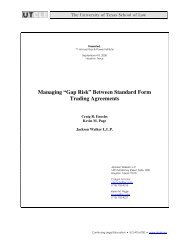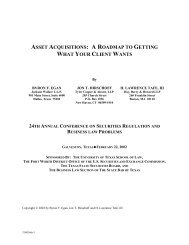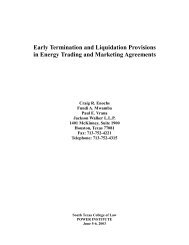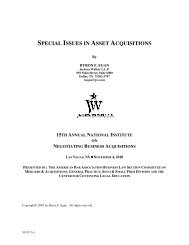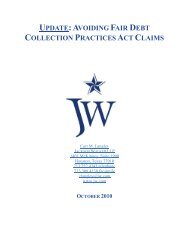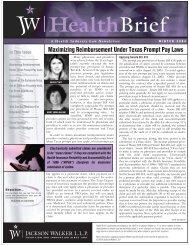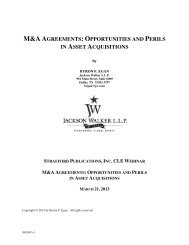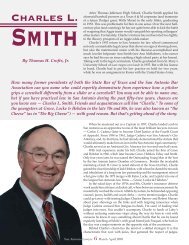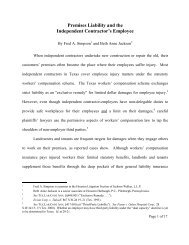Perfect 10, Inc. argued that the defendant “did not qualify for any safe harborbecause it interfered with ‘standard technical measures’ by blocking Perfect 10’saccess to [defendant] affiliated websites in order to prevent Perfect 10 fromdiscovering whether those websites infringed Perfect 10 copyrights.” 22 The NinthCircuit remanded the case to the district court because it was unable to determine onthe record “whether accessing websites is a standard technical measure, which was‘developed pursuant to a broad consensus <strong>of</strong> copyright owners and service providersin an open, fair, voluntary, multi-industry standards process.’” 23 As one commentatorwrites, “these ‘standard technical measures’ are notoriously difficult to define in thewake <strong>of</strong> changing norms <strong>of</strong> technology and surveillance. The more consumersurveillance technologies alter the fabric <strong>of</strong> cyberspace, and expand to unmask andrecord the activities and identities <strong>of</strong> Internet subscribers, the more difficult itbecomes to define and construct standard technical measures . . . ” 24In Viacom v. <strong>YouTube</strong>, Viacom asserts that <strong>YouTube</strong> failed to accommodate standardtechnical measures by implementing features that prevent copyright owners fromfinding infringing videos on the <strong>YouTube</strong> website. Viacom points out that <strong>YouTube</strong>allows its users to make hidden videos available to others through features like the“embed,” “share,” and “friends” functions.The UGC Service Provider Safe Harbor – § 512(c)UGC service providers typically invoke the protections <strong>of</strong> § 512(c). This subsectionaffords safe harbor from liability for copyright infringement “by reason <strong>of</strong> thestorage at the direction <strong>of</strong> a user <strong>of</strong> material that resides on a system or networkcontrolled or operated by or for the service provider.” To qualify for protectionunder § 512(c), a UGC provider must, in addition to satisfying the requirementsdiscussed above, meet the eligibility requirements specified in § 512(c). The serviceprovider:1. must not have “actual knowledge” <strong>of</strong> infringing activity;2. in the absence <strong>of</strong> “actual knowledge”, is not aware <strong>of</strong> facts or circumstancesfrom which infringing activity is apparent;3. upon obtaining actual knowledge or awareness, acts expeditiously to removeor disable access to the infringing material;4. does not receive a “financial benefit directly attributable to the infringingactivity”, where the service provider has the “right and ability to control”such activity;21 Perfect 10 II, 488 F.3d at 1115 (“We are unable to determine on this record whether accessing websites is a standardtechnical measure, which was ‘developed pursuant to a broad consensus <strong>of</strong> copyright owners and service providers in anopen, fair, voluntary, multiindustry standards process’”).22 Id.23 Id. (citation omitted).24 Sonia K. Katyal, Privacy vs. Piracy, 7 Yale J. L. & Tech. 222 (2005).6
5. upon proper notification <strong>of</strong> claimed infringement, responds expeditiously toremove or disable access to infringing materials;6. has designated an agent to receive DMCA notices and has provided requisitecontact information on its website and to the Copyright Office.Actual and Apparent Knowledge. The DMCA generally does not require affirmativemonitoring. 25 Although affirmative monitoring may be required if such monitoringbecame a “standard technical measure,” 26 such measures must be “developedpursuant to a broad consensus <strong>of</strong> copyright owners and service providers in an open,fair, voluntary, multi-industry standards process,” and there is little incentive for theservice providers to develop such a broad consensus. Thus, it seems unlikely thatthe need for any affirmative monitoring will be necessary by UGC serviceproviders. 27 Once the UGC provider becomes aware <strong>of</strong> a “red flag,” 28 it may loseliability protection if it fails to take appropriate action. To have apparent knowledgea service provider must have “turned a blind eye” to red flags <strong>of</strong> obviousinfringement. 29Direct financial benefit. The House Report 30 on the DMCA states that the financialbenefit standard is intended to codify and clarify the direct financial benefit element<strong>of</strong> vicarious liability as it has been interpreted in cases such as Marobie-FL, Inc. v.National Association <strong>of</strong> Fire Equipment Distributors. 31 So, for example, the reportprovides that receiving a one-time set-up fee and flat periodic payments for servicefrom a person engaging in infringing activities would not constitute receiving a“financial benefit directly attributable to the infringing activity.” Very importantly,however, the report states that a direct financial benefit would exist if one received25 “As stated in subsection (c)(1), a service provider need not monitor its service or affirmatively seek facts indicatinginfringing activity (except to the extent consistent with a standard technical measure complying with new subsection (h),in order to claim this limitation on liability (or, indeed any other limitation provided by the legislation).” H. Rep. No.105-551 Pt. II, at 53; see H. Rep. 105-551 Pt. I, at 26 (“Once one becomes aware <strong>of</strong> such information, however, one mayhave an obligation to check further”).26 Id.27 3 Melville B. Nimmer & David Nimmer, NIMMER ON COPYRIGHT § 12B.0[B][3] (2006).28 The legislative history provides some guidance as to what constitutes a “red flag”:The “red flag” test has both a subjective and an objective element. In determining whether theservice provider was aware <strong>of</strong> a “red flag,” the subjective awareness <strong>of</strong> the service provider <strong>of</strong> thefacts or circumstances in question must be determined. However, in deciding whether those facts orcircumstances constitute a “red flag” – in other words, whether infringing activity would have beenapparent to a reasonable person operating under the same or similar circumstances – an objectivestandard should be used.H. Rep. No. 105-551, Pt. II, at 53; see also S. Rep. No. 105-190, at 44.29 See Corbis Corp. v. Amazon.com, Inc., 351 F. Supp. 2d 1090, 1108 (W.D. Wa. 2004); Perfect 10 II, 488 F.3d at 1114-15(“[I]n order for a website to qualify as a ‘red flag’ <strong>of</strong> infringement, it would need to be apparent that the websiteinstructed or enabled users to infringe another’s copyright”; the Ninth Circuit remanded on the issues <strong>of</strong> whether thirdpartynotices made defendant aware that it provided services to repeat infringers, and if so, whether they respondedappropriately).30 H.R. Rep. 105-551(I).31 983 F.Supp. 1167, 1179 (N.D. Ill. 1997) (no direct financial benefit where defendant only received a one-time set upfee and recurring flat rate).7




